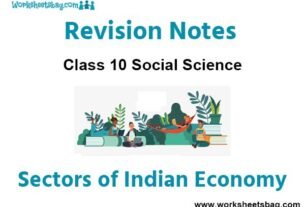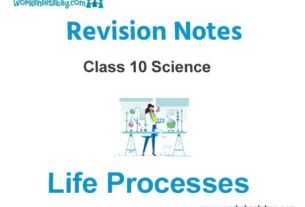Please refer to the Resources and Development Notes Class 10 Social Science given below. These revision notes have been designed as per the latest NCERT, CBSE, and KVS books issued for the current academic year. Students will be able to understand the entire chapter in your class 10th Social Science book. We have provided chapter-wise Notes for Class 10 Social Science as per the latest examination pattern.
Revision Notes Chapter 1 Resources and Development Class 10 Social Science
Students of Class 10 Social Science will be able to revise the entire chapter and also learn all important concepts based on the topic-wise notes given below. Our best teachers for Grade 10 have prepared these to help you get better marks in upcoming examinations. These revision notes cover all important topics given in this chapter.
RESOURCES AND DEVELOPMENT
Resources- Everything in our environment that can be used to satisfy your needs, which is technologically accessible, economically feasible and cultural acceptable can be termed as resources.
Types of resources-
Resources are broadly classified as natural, human and man- made resources.
Classification of resources-
Natural resources can be classified as follow:
1. ON THE BASIS OF ORIGIN
A. Biotic resources:- These resources are obtained from biosphere i.e. human beings, livestock, flora and fauna etc. coal and petroleum may be considered as biotic resources as they are formed by decaying of life forms.
B. Abiotic resources- these resources are composed of non- living e.g. soil, rocks, metals, winds, etc.
2. ON THE BASIS OF EXHAUSIBILITY OR LIMITATION OF USE
A. Renewable resources- The resources which can be renewed or reproduced by physical, chemical or mechanical processes are known as renewable or replenishable resources e.g. solar energy, wind energy, forest, water, wildlife, etc. it can be further sub- divided into two forms.
-Flow or continuous resource
These resource can be used and replenished at the same time. It does not remain in one location and moves about because of natural actions in the physical environment e.g. running water, solar radiation, winds and tides.
-Biological resource
These resources are formed by biological process. It is further divided into two parts
-Natural vegetation [forest cover or flora]
-Wildlife [fauna]
B. Non – renewable resources- These resources are formed through long geological time period and cannot be renewed e.g. minerals, metals, and fossil fuels. These resources may further be divided-
-Recyclable metals can be recycled by technological application so they are recyclable.
-Non recyclable-fossils fuels burn readily and cannot be recycled so they are non recyclable.
3. ON THE BASIS OF OWNERSHIP
A. Individual resources- These resources are owned privately by individuals e.g. plantation, pasture land, farmland, water in well, pond, etc.
B. Community owned resources- These resources are accessible to all the members of the community e.g. grazing grounds, burial grounds, ponds in village, public parks, etc.
C. National resources- These resources are under the control of nation/country e.g. canal, coal mines, territorial sea. [upto 12 nautical miles from the coast] railway, etc.
D. International resources- These resources are owned and regulated by international institution e.g. open sea used for peaceful navigation, open sky for flight movements, etc. The oceanic resources beyond 200 nautical miles of the exclusive economic zone belong to open sea.
4. ON THE BASIS OF THE STATUS OF DEVELOPMENT
A. Potential resources- These resources are found in a region in abundance, but have not been developed properly e.g. solar and wind energy in Gujarat and Rajasthan , vast tidal waves in the coasts of India.
B. Developed resources- These resources are surveyed and quantified for utilization through available technology e.g. coal, petroleum, etc. availability of technology and level of accessibility decides the quality of developed resources.
C. Stock- These resources have the potential to satisfy human need, the required technical knowledge to use them is not developed e.g. hydrogen and oxygen in water can be a
rich resource of energy. But technical know-how for this purpose is not available.
D. Reserves- These are specific stocks for which appropriate technological know-how is available, but exploration is not started yet. E.g. river water for hydel energy or forest are reserves but still has limited exploration.
INTERDEPENDENT RELATIONSHIP BETWEEN NATURE, TECHNOLOGY AND INSTITUTIONS
-The process of transformation of things available in our environment involves an interactive relationship between nature, technology and institutions. Human beings interact with nature through technology and create institutions to accelerate their economic development.
PROBLEMS DUE TO OVER UTILIZATION OF RESOURCES
Resources are vital for human survival as well as for maintaining the quality of life. It was believed that resources are free gift of nature. As the result, human beings used them indiscriminately and this has led to the following major problems.
1. Depletion of resources- Due to the satisfying the greed of the few individuals resources are depleted.
2. Economical division of society- Unequal resource distribution which created accumulation of resources in few hands. Which in turn divided the society into two segments i.e. rich and poor
3. Global ecological crises– Indiscriminate exploitation of resources has led to global ecological crises such as, global warming, ozone layer depletion, environmental pollution and land degradation.
SUSTAINABLE DEVELOPMENT
-Sustainable economic development means development should take place without damaging the environment, and development in the present should not compromise with the needs of the future generation.
RIO DE JANEIRO EARTH SUMMIT, 1992
1. In June 1992, more than 100 heads of states met in Rio de Janeiro in Brazil, for the first international earth summit.
2. The summit was convened for addressing urgent problems of environmental protection and socioeconomic development at the global level.
3. The assembled leaders signed the declaration on global climatic change and biological diversity.
4. The Rio convention endorsed the global forest principles and adopted agenda 21 for achieving sustainable development in the 21st century.
AGENDA 21
1. It is the declaration signed by world leaders in 1992 at the united nations conference on environment and development [UNCED], which took place at Rio de Janeiro, brazil.
2. It aims at achieving global sustainable development.
3. It is an agenda to combat environmental damage, poverty, Disease through global co- operation.
4. One major objective of the agenda 21 is that every local government should draw its own local agenda 21.
RESOURCE PLANNING
-Planning is the widely accepted strategy for judicious use of resources. Resource planning means identification and quantification of the available resources along with their development. Resource planning should match with national development goals.
STEPS OR PROCESS OF RESOURCE PLANNING
Resource planning is a complex process which involves:-
1. Identification and inventory of resources across the regions of the country. This involves surveying, mapping, qualitative and quantitative estimation and measurement of the resources.
2. Evolving a planning structure endowed with appropriate technology, skill and institutional set up for implementing resource development plans.
3. Matching the resource development plans with overall national development plans.
India has made concerted efforts for achieving the goals of resources planning right from the first five year plan launched after independence.
RESOURCE PLANNING IN INDIA
Resource planning has importance in a country like India, which has enormous diversity in the availability of resources. There are religious which are rich in certain types of resources but are deficient in some other resources. There are some regions which can be considered Self Sufficient in terms of the availability of resources and there are some regions which have acute shortage of some vital resources. Some examples are as follows:-
-states like Jharkhand, Chhattisgarh and Madhya Pradesh are rich in coal and minerals, but lack technologically and institutional support.
-Arunachal Pradesh has abundant water resources, but lacks in infrastructure development.
-Rajasthan is well endowed with wind and solar energy, but lacks water resources.
-Some states like Punjab, Haryana have a poor resource base, but they are economically developed.
-The cold desert of Ladakh lacks natural resources, although it has a rich cultural heritage.
RESOURCES AND COLONISATION
1. The history of colonization reveals that rich resources in colonies were the main attractions for the foreign invaders.
2. It was primarily the higher level of technological development of the colonizing countries that helped them to exploit resources of other regions and establish their supremacy over the colonies.
3. Therefore, resources can contribute to development only when they are accompanied by appropriate technological development and institutional changes.
4. India has experienced all this in different
phases of colonization. Therefore, in India, development, in general, and resources development in particular does not only involve the availability of resources, but also the technology, quality of human resources and the historical experiences of the people.
CONSERVATION OF RESOURCES
1. Resources are vital for any developmental activity. But irrational consumption and over utilization of resources may lead to socioeconomic and environmental problems.
2. To overcome these problems, resource conversion at various levels is important.
3. This had been the main concern of the leaders and thinkers in the past.
4. Gandhiji was very apt in voicing his concern about resource conservation in these words. There is enough for everybody need and not for anybody greed. He placed the greedy and selfish individuals and exploitative nature of modern technology as the root cause for resource depletion at the global level. He was against mass production and wanted to replace it with the production by the masses.
5. At the international level, the club of Rome advocated resource conservation for the first time in a more systematic way in 1968.
6. The seminal contribution with respect to resource conservation at the global level was made by the Brundtland commission report, 1987.
7. Another significant contribution was made at the earth summit at Rio de Janeiro, Brazil in 1992.


